Characteristics of the types[edit | edit source]
In a simple form, the furnace can be a cylindrical hole dug in the ground, where the vertical wall is lined with cemented bricks. A refractory cement allows a longer lifetime.
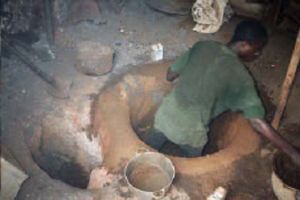
In the bottom of the holes, we find a full cylinder on which a melting pot is placed which allows a better exposure of the melting pot to the flames, the "cheese" of which the diameter must match that of the base of the melting pot. Air inlet Cheese melting pot
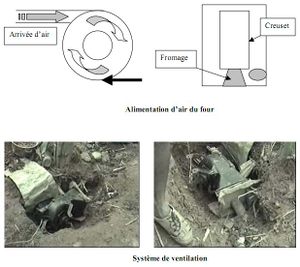
The diameter of the furnace depends on:
- The capacity of the melting pot, its diameter, and;
- The average size of the charcoal pieces.
The dimensions of the furnace made in Yaounde, on the occasion of the intervention of ISF in October 2004 are: Ø: 500 Depth: 700 mm Height of the cheese: 180 mm. It was intended to receive a melting pot with a capacity of 60 kg of aluminium. A fan-recovery turbine sends the air necessary for combustion into piping leading into the lower cylindrical furnace. Quite often, the air intake with the combustion gases such as those of coal, coke and charcoal is made at the bottom of the oven, which was not included here. If the air is introduced a bit higher, tangentially to the wall of the furnace -which somewhat simplifies the design of the furnace- we can multiply the supply of air to activate combustion. If we adopt more, we must ensure that they do not interact. It will thus be limited to two entrances, the design which also allows modules and easy adjustment of a heater. Between the melting pot and the wall of the kiln, we must leave a minimum space equivalent to 2 times the size of the largest pieces of charcoal, to facilitate the descent of the latter during combustion. A minimum of 10 mm indicates itself on the other hand, taking into accountthe expansion of the melting pot.
Having 2 or 3 furnaces of different sizes can tailor the amount of molten metal to the importance of contracts in progress and possibly avoid an accidental breaking of a melting pot. A second hole is generally foreseen, dug deeper and near the first to collect the metal of the melting pot in the event of a accidental breaking. The two wells are connected in their heart by a sloping fairway. A steel rod is placed permanently.
During the breaking, the metal flows into the second well. The bar allows to extract the metal after solidification. Another type of standard furnace of 200l. seen in Douala in particular and also used in Peru, is made up of a typical oilbarrel put on the floor, covered with a layer of poteyé bricks. The poteyage can be done:
- either by a mixture of clay, silica sand, respective volumes of 1/3 and 2/3, and crottin (or ashes of rice husks, or diatomite)
- or by clay, silica sand, ash of rice husks and jasmine.
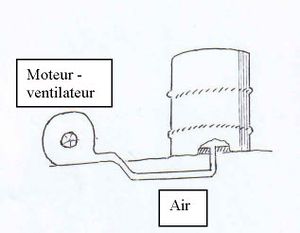
This type of furnace resists 2/3 heaters. While casting, access to the molten aluminum will be less easy. Can be used for conventional ventilation, an engine salvaged from a washing machine. In the event of failure, it is advisable to provide a training manual for the fan: a bicycle wheel, pedals and demultiplication, as seen in Douala.
The operation of the furnace[edit | edit source]
While conducting the merger, you should pay attention mainly to two things:
- The formation of dross, metal oxides, blown by the wind,
- The porosity of solid metal that may occur by absorption of fusion gases.
The second phenomenon has been seen as a less critical factor in the foundry of Yaoundé which was assisted by ISF. To limit the formation of oxides, we may spread in the bath area a thin layer of sand or, preferably charcoal. It is also important to dry the tools that will be in contact with the liquid metal.
Precautions[edit | edit source]
At the commissioning of the furnace: a furnace unused for several months demands drying before bringing it to to a red and then dark red color (750°C). The moisture in the coating of the furnace requires some experience to the operation. Experience such as the craftsmen have is good, it is good to consult them because of the danger of explosion that can occur when it is heated too fast. A manufactured furnace requires a drying in the open air, followed by entry into service in two stages: elimination of moisture in the form of visible water vapor, and then cooking. At the level of furnace operation, you should
- Merge as soon as possible to avoid a maximum of dross.
- Avoid the insertion of cold chips which form large quantities of dross (oxides)
- Pack charcoal to avoid pulling too high.
- Load aluminum alloy very often, the heaviest ones first, profiles afterwards, and finally electric cables.
The first have usually a lower melting point, and for a bath to receive the second ones.
Findings of the temperature of molten metal[edit | edit source]
Without knowledge of the composition of molten metal and without measuring instrument, it is difficult to assess the ideal pouring temperature. Especially since this composition can vary depending on the type of scrap melted. Ideally, during the casting, the molten metal will be in the range of precise temperatures and therefore must be able to meet the following three questions:
- Is the temperature high enough?
- Is the temperature not too high?
- Does it contain gaseous inclusions?
Three small assessment tests are sometimes used to estimate the temperature of casting:
- dark red:
- Hardening of a steel wire, kind of concrete iron in the mixture. If during the removal, the aluminum does not stick, the pouring temperature is reached.
- testing the presence of gas in the metal, despite a degassing:
- take a sample of metal in a small dish of a slight tronconical form, with dimensions Ø 45, Ø 40, H 35 mm;
- In the case of bubbling during solidification and a upper surface which is curved upwards without retassure, there is presence of gas in the melted metal.
- detecting a too high temperature causes expelling of gas from the metal:
- On a preheated stone, sink a little metal
- In the case of bubbles while the temperature is near or above 800° C, there is escaping gas.
These latter two tests are useful only if they are carried out together with a degassing operation, described in the appendix. It is only useful in cases where one wishes to obtain an upper surface of high quality.
melting pot[edit | edit source]
Poteyage For non-critical quality parts, as kitchen equipment, all types of cylindrical steel containers can be used, provided it is poteyé, by a layer of clay or refractory cement.
Pottery formula with clay: 2 parts of dry silica sand, 1 part clay refractory, as clear as possible.
After mixing, add water to get the same consistency as that of a painting. Before use, poteyage must be very carefully dried for 2 to 3 days. The poteyage is carefully mixed and expanded to ensure that no air pockets are are formed. The melting pot is dried at low heat during the first 2 to 3 hours, the time required to evacuate water vapor and then heated until red and then quickly to bright red. It is cooled slowly, all holes plugged. If it has been stored for a number of days at the beginning of the heating of the furnace, it is important to moderate the pace of firing, for its drying. Dimensions The choice of the appropriate size of the melting pot depends on a set of elements. It primarily depends on:
- Availability of raw materials, scrap, and quality
- The area available for the disposal of molds
- Availability of labor force, usually of independant status
- The energy consumption.
This choice therefore influences thus the working capital. We will therefore foresee melting pots and furnaces of different sizes, as illustrated in a schematic above on the schematic of the workshop. Melting pots of a capacity of 600 kg of molten metal were seen in Yaounde: made of a section of cast iron water pipe, to which a foundation has been welded. This particular important dimension was justified by the desire to limit the time of rental of the workshop and also to meet large orders. However, this presents a risk of some loss of metal in case of production incidents such, perforation of the melting pot, inadequate composition of the molten metal. It also requires solid means of handling, a hoist ... This is why melting pots of such capacity are quite rare.
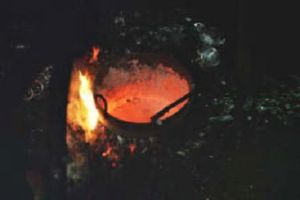
Small melting pots are often operated by only one person. In the business, we also find melting pots of standard sizes made of graphite, silicon carbide ... unfortunately at a very high cost. These are imported products. Commissioning of the furnace/Precautions The local artisans can usually easily inform themselves about the precautions to take in regards to the heater in order to avoid accidental or premature degradation.
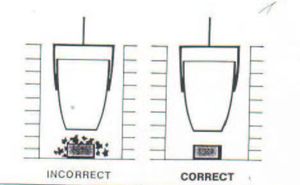
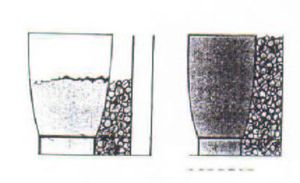
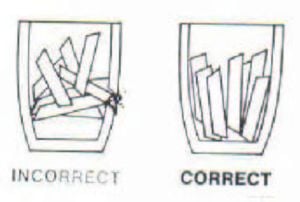
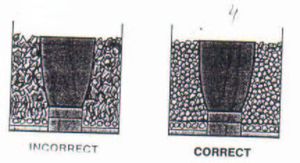
Precautions to be taken before use
- No fuel between cheese and melting pot
- Level of leveled charcoal coming over the top of the crueset to have a uniform heating and to avoid any horizontal rupture of the melting pot.
- Loading of waste long, vertically
- melting pot not too low in the furnace for fear of causing a slit in the lower tiers
- An average size of charcoal also prevents too intense and localized flames that lick the surface off the melting pot and provoke rupture.
- The level of molten metal near the top of the melting pot.
Casting[edit | edit source]
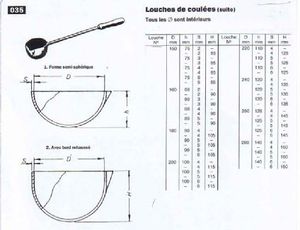
Before starting on this operation, we must take care to slowly stir the liquid with a corny (steel rod) poteyé so to stir up the surface oxides possibly in suspension and then skim the "filth" floating untop of the surface of the bath, using a skimmer. The casting will often pick the ladle of molten Al, directly into the melting pot. If maneuvers are being simplified, one can proceed in two stages and use a pocket from which then flows on the molten metal, in series.
The feeding of the liquid into the molds must be done while avoiding turbulence which can promote contact between air/metal and therefore the formation of alumina and without interrupting the stream of casting, which should get the funnel full. Eventually, when the casting is complete, a thin layer of magnesia is sprinkled on the mass. By reaction with aluminum, it maintains for a certain time the level of temperature of liquid (or already paste) aluminum.
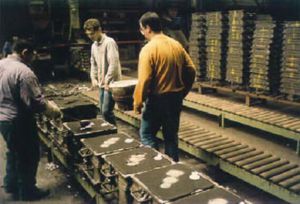
Materials poteyées ladles: already mentioned in other paragraphs Skimmer Pockets: see above Stretchers: To enable the handling of ladles, handling them is done using stretchers made by two operators of which one provides the rotation the pocket casting of Al into the funnel of each mold. Magnesia powder: reaction magnesite + aluminum releases heat in the mass, and keeps it liquid longer.
Precaution All utensils coming in contact with the molten metal must be carefully poteyés to avoid risk of explosion.
Cleaning the melting pot At the end of casting, a residue of molten metal and slag remains in the melting pot,these come from dirt, supernatant. They must be removed before the next cast.
Finish[edit | edit source]
Is done by the following steps:
- Demoulding ie, removal of the casting <<décochage>>.
- Light cleaning with a brush to remove any sand adhering to the workpiece
- Cutting and mass of the casting jes by shears, by means of a saw or disc
- Light sanding outside and inside the room by abrasive sander belt
- Polishing the drum of the pan set in a chuck, if necessary.
This polishing operation is significantly less than that currently done on traditional pots made in Cameroon today.
Materials

The following equipment may be justified
- A band saw (blade without end), to remove the weights and possible casting jets, commonly used in joineries as foundries, ...
- Blades for Aluminum to lubricate for thicknesses > 4mm
- A abrasive endless sander belt, commonly used in carpentry
- A "disqueuse".
- A lathe with a chuck claw keeping objects in cylindrical symmetry, which can come either from an old tower or metal timber equipped with an electric motor, or a potter's wheel, or a transformed remoulding machine, equipped or not an electric motor. Means also polishing procedure. Use with paper or abrasive canvas with manual maintenance rubbing against the object by polishing in cylindrical symmetry of rotation. Vitesse: ~ 300/400 rpm, for the abrasive canvas. The paper is kept in contact with the pot by polishing by hand.
- A system of dust suction, or masks to protect against dust, they are however unpleasant to use with the high temperatures.
- The use of abrasive belts for the surface sanding may have the disadvantage of showing inclusions and pores that would still be present under the skin of the same part.
Small tools
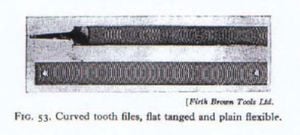
- Hacksaw for aluminum
- Toothed limes scaled for radial parallel, for non-ferrous metals
- Corundum abrasive paper, delivered in the form of tape, the grain 80 gives an excellent result, tested on traditionally manufactured pots.